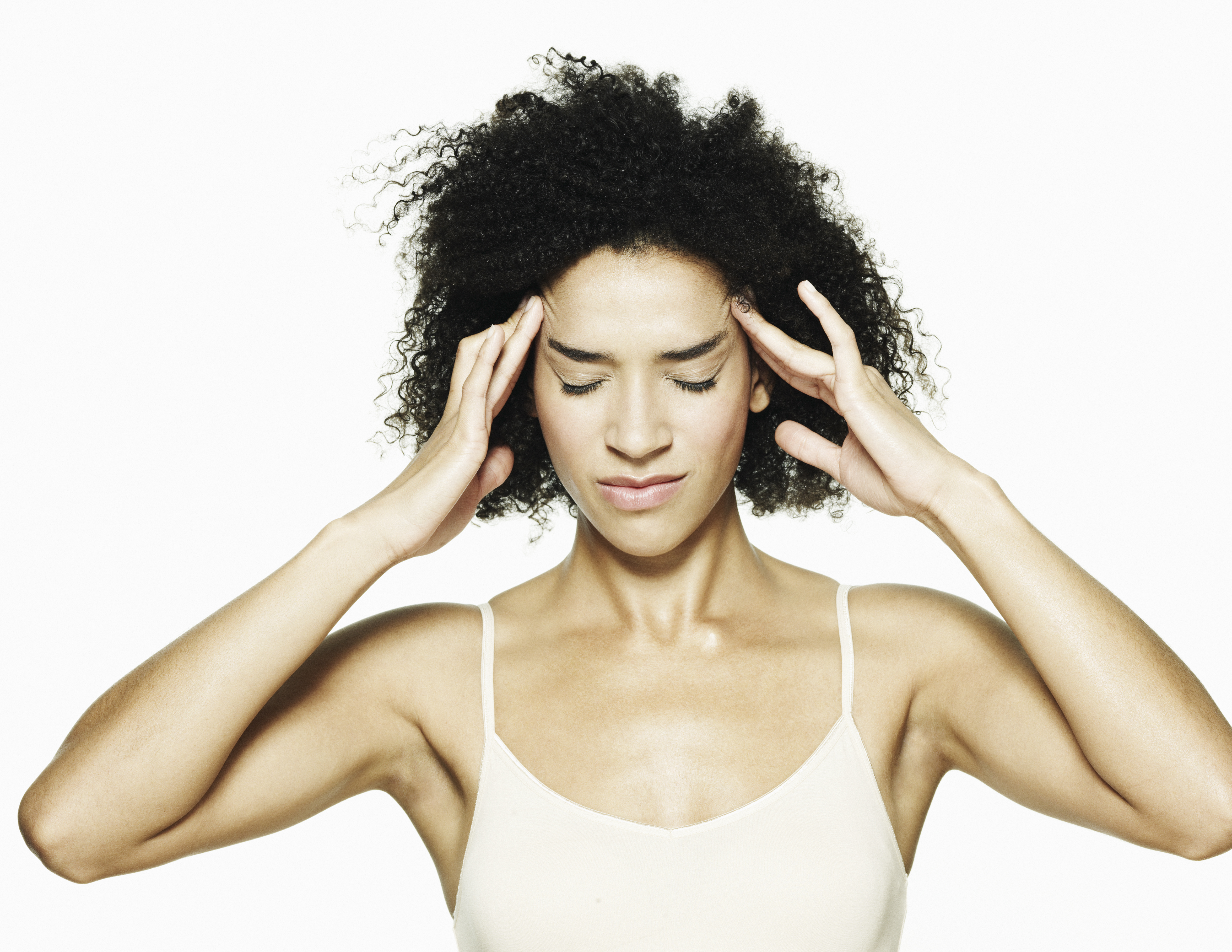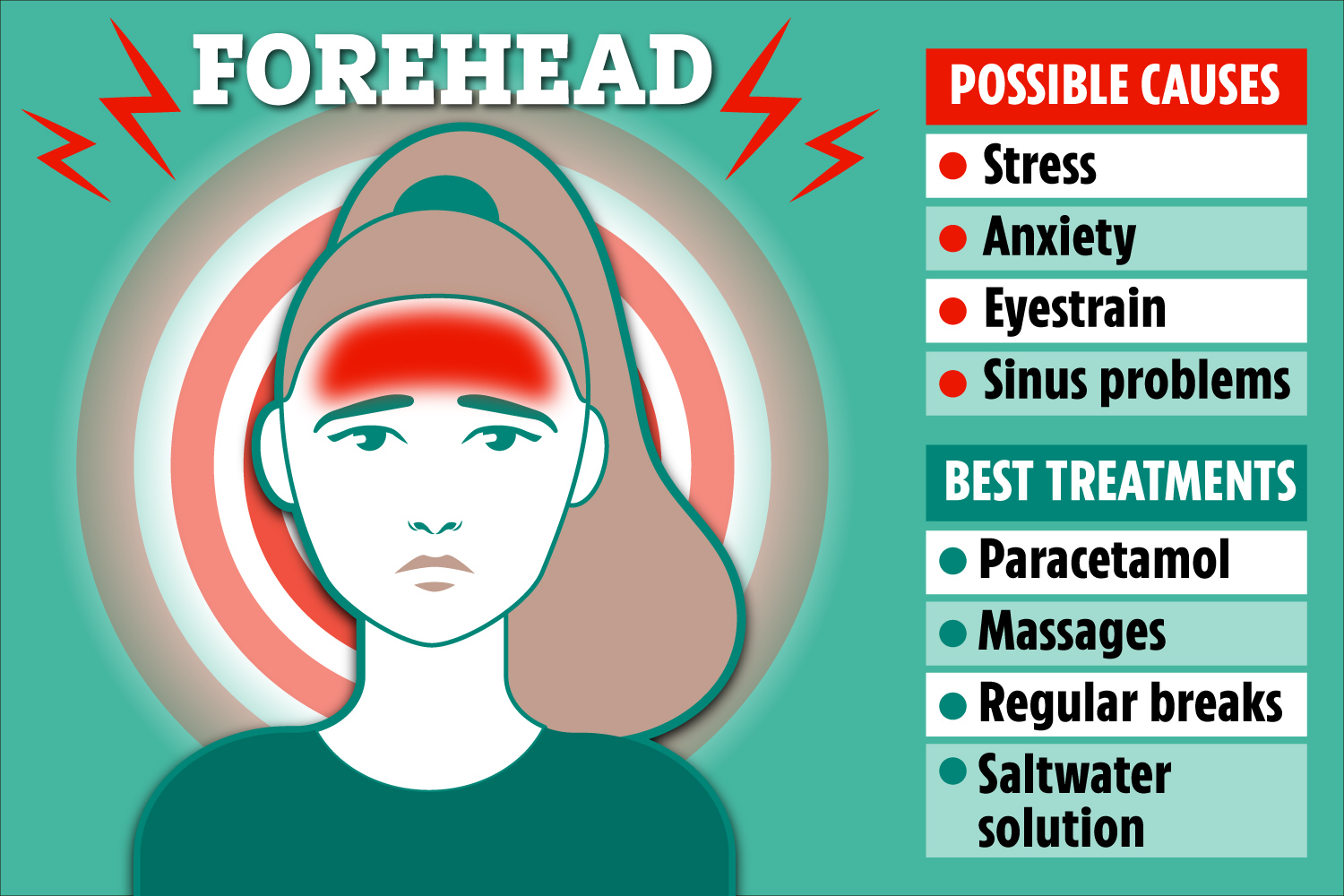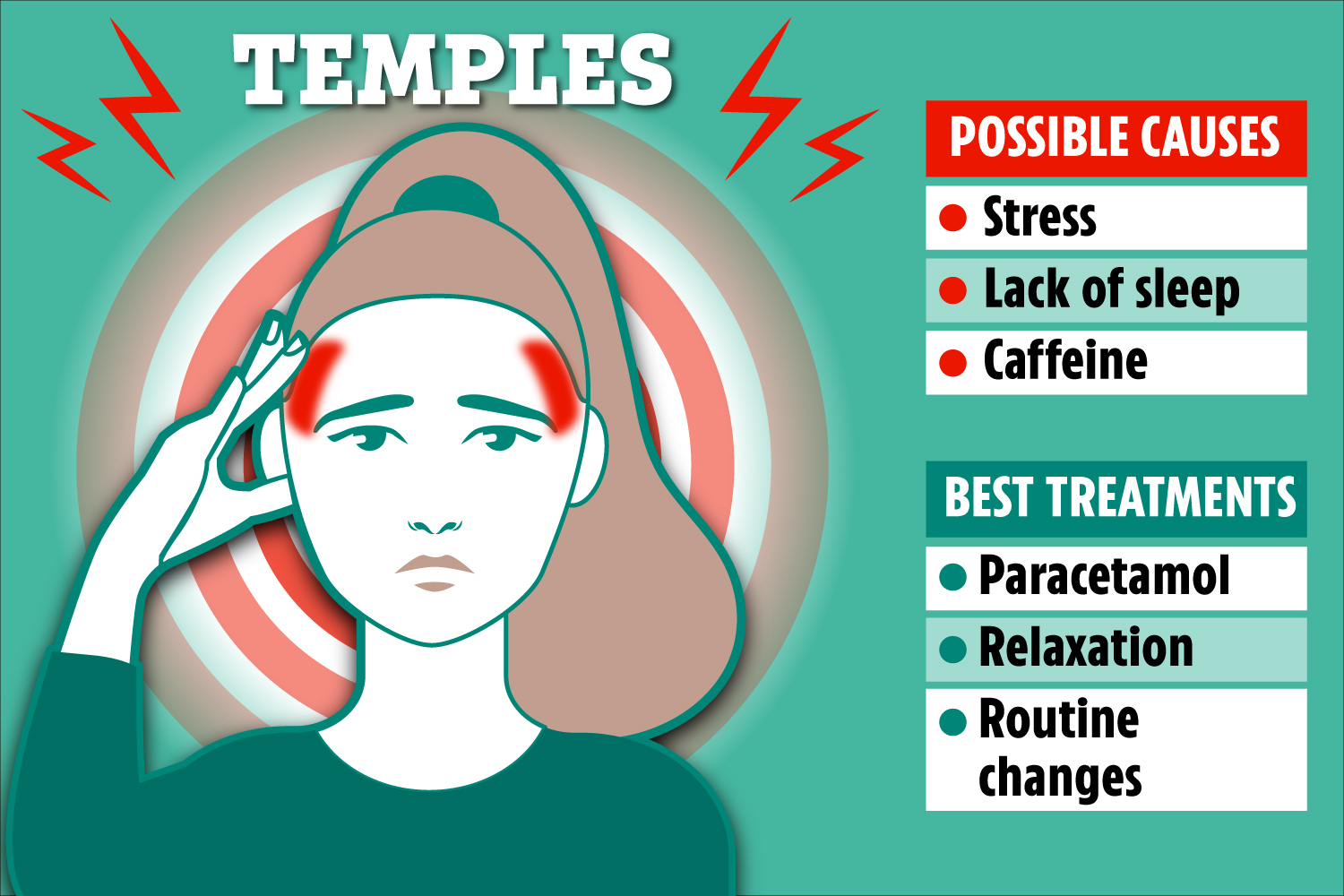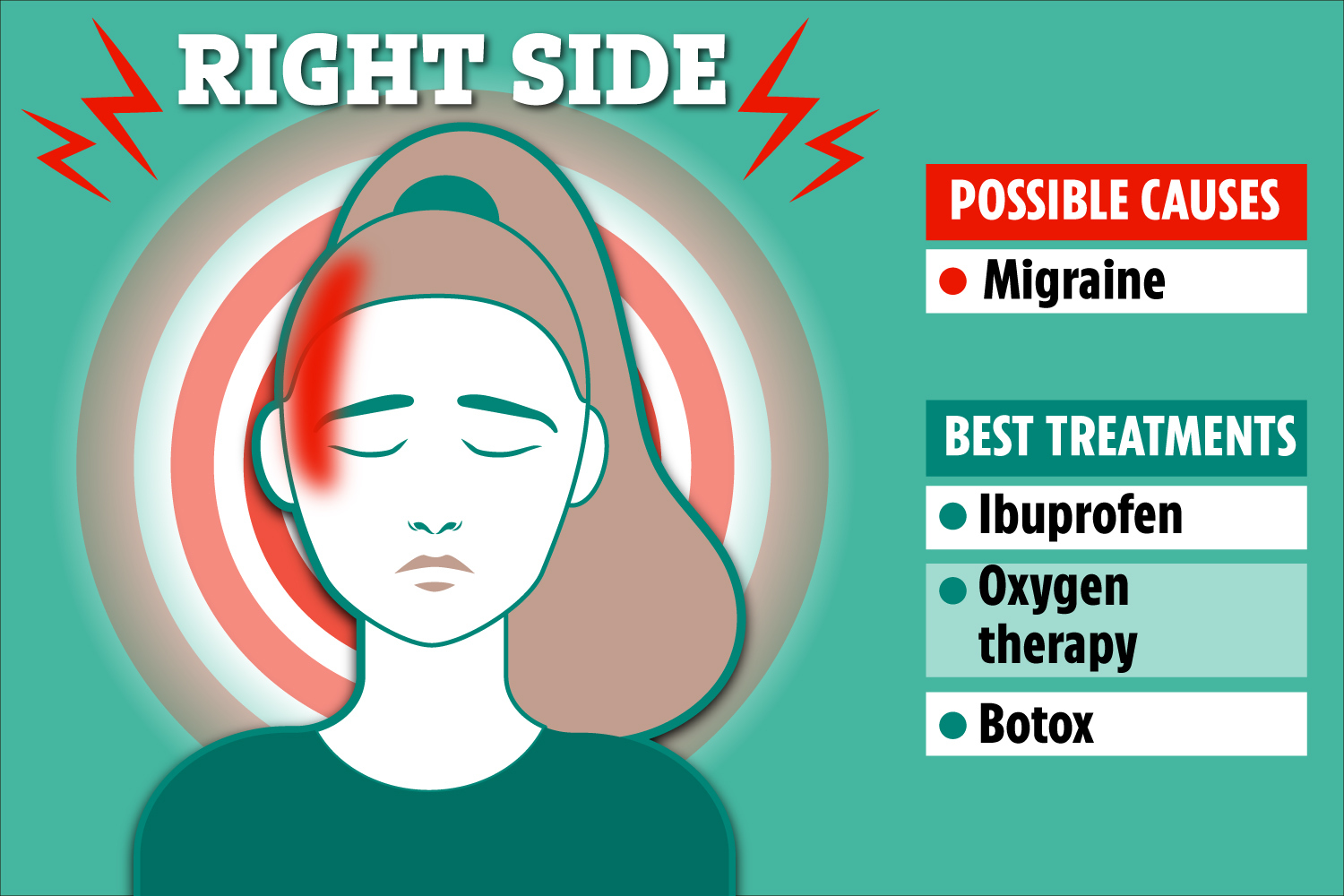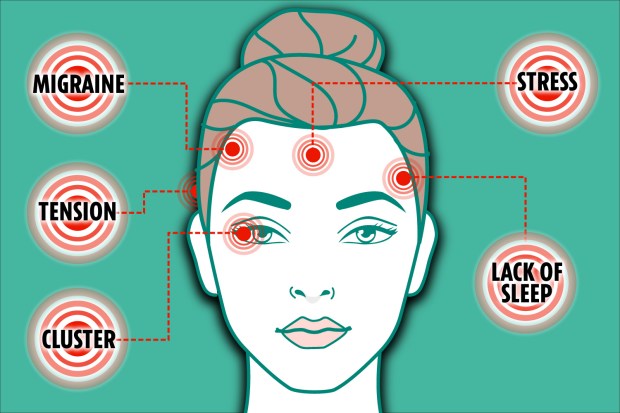
What the location of your headache means – and the best way to treat each kind of pain
HEADACHES are a real pain - literally.
It can be easy to knock back a couple of paracetamol tablets and hope the agony will quickly disappear, but it isn't quite that simple.
It turns out there are numerous different types of headache, and specific ways to best treat each one.
The location of the throbbing is the key indicator, according to pharmacist Abbas Kanani.
If it's in your forehead, for example, you could be anxious, but if temple pain is driving you insane, you might be sleep deprived.
One requires ibuprofen and a massage, while cold packs should minimise the other.
Here, Abbas explains what the position of your headache can mean - and the most effective way to dull each kind.
Forehead
Possible cause: tension
Best treatments: paracetamol, massages, a hot shower
One of the biggest triggers for a throbbing in your forehead is tension, according to Abbas, from online pharmacy Chemist Click.
Most read in Health
He said: "Stress, anxiety and depression often trigger tension headaches, but they can also occur due to tiredness, bad posture, and musculoskeletal problems in the neck."
Thankfully, this kind of pain is easily relieved with over-the-counter medicines such as ibuprofen or aspirin.
"Head massages, exercising the neck gently, taking a hot shower or placing a hot towel or washcloth on the forehead or neck can also help," he added.
Possible cause: eyestrain
Best treatments: regular breaks, good posture, get checked
"Headaches caused by eyestrain may feel similar to tension headaches and can be caused by prolonged reading or computer use, extended periods of concentration, stress, and bad posture," Abbas said.
If you're experiencing this kind of discomfort, you should book an eye test as you may require glasses or contact lenses, he added.
"Taking regular breaks from reading and screens, practising good posture, and stretching the neck, arms and backs regularly can all help minimise your risk of eyestrain headaches," the pharmacist said.
"You can also use an anti-glare filter for your computer screen."
Possible cause: sinus problems
Best treatments: saltwater solution, cold and flu medicine, ibuprofen
Another common source of forehead pain is sinus problems, usually as a result of an infection or allergic reaction, according to Abbas.
"This can cause frontal headaches and tenderness around the forehead, cheeks, and eyes," he said.
"People often have sinusitis following a cold or the flu, and it usually resolves without treatment.
"But you may be able to relieve the associated congestion by using saltwater solution to clear their nostrils or inhale steam from a bowl of hot water.
"If the sinusitis is caused by cold and flu, over-the-counter nasal decongestants and pain relievers, such as ibuprofen can help.
"A doctor may prescribe an antibiotic if it is caused by a bacterial infection, or an antihistamine if caused by an allergy."
Temples
Possible cause: stress
Best treatments: paracetamol, relaxation techniques
Stress is our body's response to pressure or feeling threatened. Unsurprisingly, with it can come agonising headaches.
These tend to occur in the temples, and usually feel like a throbbing pain, tenderness or a dull ache.
Painkillers such as paracetamol, aspirin, and ibuprofen can really help, Abbas said.
"Paracetamol is the first choice if you're pregnant, and children under 16 should not take aspirin," the expert added.
Activities to help you relax like exercise, yoga and massage may also help relieve stress and reduce headaches, according to the pharmacist.
Possible cause: lack of sleep
Best treatments: altering your routine, swapping your pillow, cold packs
Tiredness can also manifest in the temples and make life pretty miserable.
Luckily, some simple tweaks to your sleeping habits - such as trying to get up and go to bed around the same time every day, avoiding naps, and limiting your caffeine intake - can make a real difference to your slumber and energy levels.
"Also, try using a low, firm pillow and heat or cold packs if you have neck pain and headaches," Abbas added.
Possible cause: too much caffeine
Best treatments: cut back
Adults should consume no more than 400mg of caffeine each day, according to the European Food Safety Authority.
There is about 40mg in a can of Coca Cola, 50mg in a cup of black tea, 80mg in an espresso, and 160mg in a large canned energy drink.
Some people are more sensitive than others, but if you are knocking back close to or more than the recommended allowance and you are experiencing headaches, you might want to think about cutting back.
Do it slowly, however, as rapid withdrawal may make your headaches worse.
Back of the head
Possible cause: tension
Best treatments: cold packs, peace and quiet, physical therapy
As well as the forehead, tension can also be felt towards the back of the head.
"Using flexible cold packs or masks, staying in a quiet, darkened room, and sleeping when necessary can lessen symptoms," Abbas said.
"Some people find acupuncture, neck exercises or physical therapy also help with headaches at the back of the head."
Right side
Possible cause: migraine
Best treatments: ibuprofen, oxygen therapy, Botox
Migraine sufferers will often experience aches on the right side of their head, Abbas said.
There is no one single cause, but the NHS says some people find starting their period, anxiety, and skipping meals to set symptoms off.
Depending on the severity, there are different treatments on offer.
"Over-the-counter pain relievers and oxygen therapy may offer relief with headaches on the right side," the expert said.
"There is no cure for migraine, but many sufferers find that ibuprofen tablets provide effective relief from their symptoms.
"There is also Botox or preventative treatment such as propranolol or topiramate."
Abbas highlighted that pain on the right side of the head can also be an indicator of more serious underlying conditions such as trauma, aneurysm, tumours and stroke so it is important to see a doctor if it persists.
Behind the eyes
Possible cause: cluster
Best treatments: prescription medication, oxygen therapy
"The main symptom of a cluster headache is a sharp, burning or piercing pain, usually on one side of the head and around the eye," Abbas said.
"They tend to happen at the same time of year or at set times of the day, and they start and stop quickly, without warning."
It's not known exactly what causes them, but the NHS says smoking, drinking alcohol, exercise, perfume and the smell of paint, nail varnish or petrol can all be triggers.
This type of headache can be treated with triptans such as sumatriptan, which is available on prescription.
Read More on The US Sun
It works by narrowing blood vessels in the head, preventing pain signals from being sent to the brain.
"Oxygen, breathed through a mask or using a device to give mild electrical pulses to the back of the neck, can also help," Abbas added.


